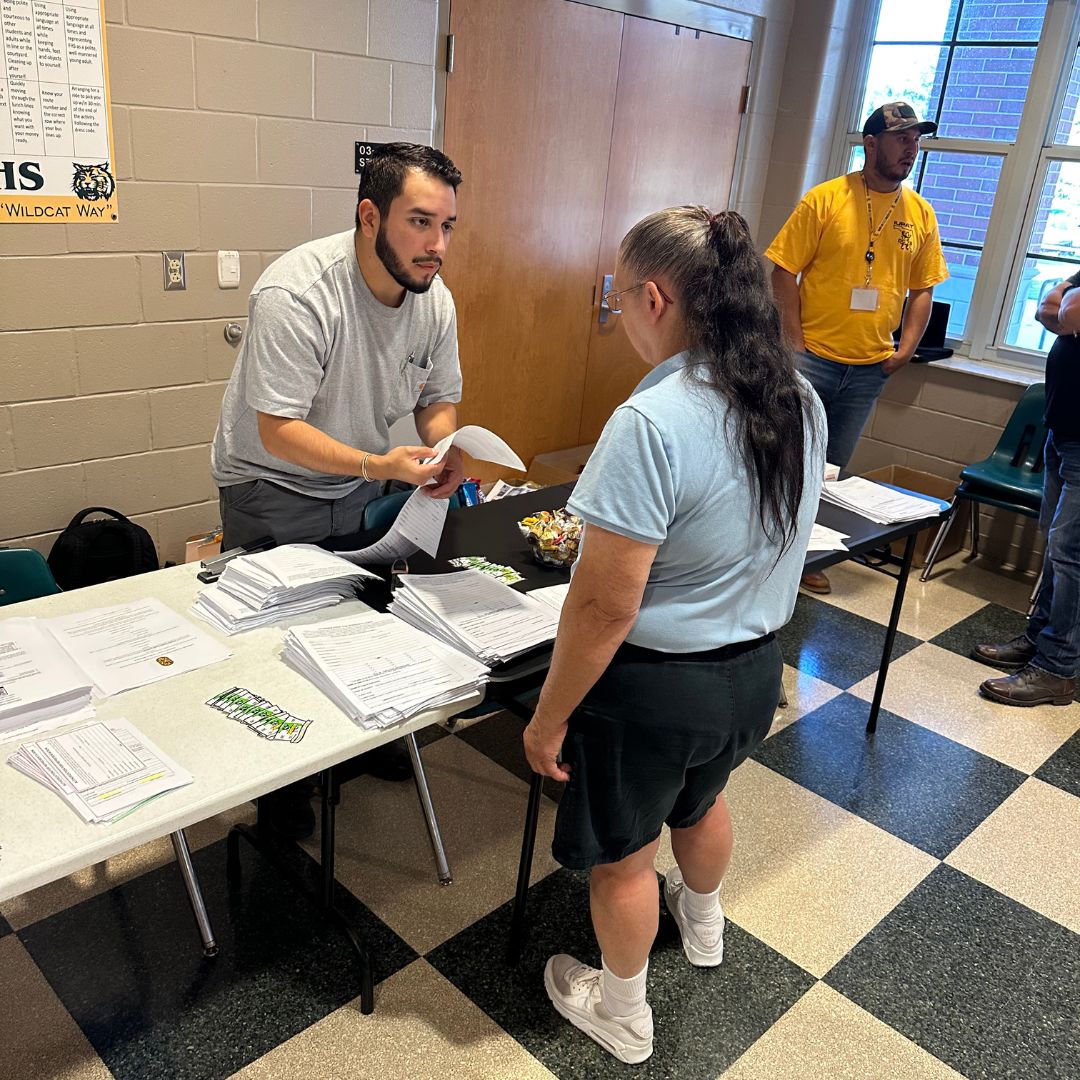
The International Union of Painters and Allied Trades (IUPAT) represents over 160,000 people in the United States and Canada who work as industrial and commercial painters, drywall finishers, glass workers, sign makers, and more. In short, IUPAT members’ skills are in high demand at every construction project in North America, and their impact extends far beyond the workplace. Members fight for workers’ rights and undertake effective political mobilization to benefit their communities.
In Florida, the IUPAT has been hard at work fighting back against anti-union legislation that attacks public sector workers coming out of the state government. Action Builder has played a crucial role in that organizing work, and I had a chance to chat with Kellie Morgan, IUPAT International Representative supporting the Florida District Council in their campaign against Senate Bill 256.
Hi Kellie, can you introduce yourself and your role at the IUPAT?
My name is Kellie Morgan, and I work with the International Union of Painters and Allied Trades (IUPAT) as the Grassroots Mobilizer and Community Partner Coordinator. Currently, I’m supporting our district council on the ground with a campaign against a piece of legislation that recently passed in Florida, Senate Bill 256.
Senate Bill 256 was enacted by the Florida State House, and it mandates that if a collective bargaining agreement or a union does not maintain 60% membership, it will face decertification. Additionally, the legislation stipulates that unions can no longer deduct dues directly from payroll; instead, dues must be paid directly by the employee to the union.
This law went into effect on July 1st, 2024. For the past year, we’ve been tirelessly campaigning against this legislation, working alongside other public employee unions in the state. A significant part of our success, in terms of organization and logistics, can be attributed to having a powerful tool like Action Builder in our toolkit.
“I can’t see how we would have managed the campaign with spreadsheets and paper lists alone.”
With this legislation taking effect, what was the goal of the organizing? Are you now trying to organize around repeal or is it about ensuring union members are contributing?
Our immediate goal was to ensure that our existing members re-signed and continued as dues-paying members under the new rules of the legislation. Additionally, we aimed to organize new members and have them authorize the IUPAT as their sole representative under the collective bargaining agreement.
We set out to achieve two primary objectives: re-enroll our previous members as dues-paying members and/or have them sign an authorization card. This would allow us to reach the 30% threshold required to file for a PERC (Public Employee Relations Commission) election.

Just to provide some context, we created 13 different campaigns in Action Builder for our 13 units, comprising a total of 9,350 workers. Thanks to our efforts, we managed to retain all our collective bargaining agreements. Five of the 13 units achieved the 60% membership threshold, while the remaining units reached the 30% needed to file for a PERC election. We recently received confirmation from the state that all the units we filed for a PERC election have met the requirements, and now we’re moving into election mode. We’ll be using Action Builder to engage with members and secure their ballots in favor of keeping the collective bargaining agreement.
Additionally, with the support of Shelly Wen, Senior Organizing Data Strategist from the AFL-CIO, we developed training videos. These videos were instrumental in preparing over 229 volunteers from across the country who came to support our campaign. The videos provided quick tutorials on using Action Builder, conducting phone banks, locating members at their homes or job sites, and understanding job titles to effectively find and engage members on-site. This was particularly useful since our volunteers often only stayed for a week, requiring continuous training. The short, informative videos ensured that we had the logistics and information needed to effectively manage ground operations, even with a constantly changing team.
“I genuinely believe you all did an amazing job making sure that the tool was user-friendly and accessible for everyone, regardless of their tech-savviness.”
One of the goals that we had when we were building Action Builder was to ensure that folks actually use it. And if you want folks to use it, they need to be able to get up and running on it pretty quickly. And that’s not just the computer savvy people, the computer savvy organizers, it has to be everyone. So what was that onboarding like?
As you know, we’re a union full of construction workers, and it’s no shade to them, but a majority of them don’t have to use computers in their day-to-day work. The fact that the videos were simple and easy to follow made a huge difference. They were able to quickly utilize the tool and pull information from the database, which included detailed one-on-one conversations about the people they were speaking to. This made the interactions much more meaningful and less superficial.

The ability to dive deeper into issues, discuss pay concerns, and reference notes left by other organizers allowed for continuous and enriched conversations. This ensured that our organizers could build on previous interactions, making each conversation more effective. I genuinely believe you all did an amazing job making sure that the tool was user-friendly and accessible for everyone, regardless of their tech-savviness.
“Being able to cut lists and go into job sites with a clear plan, calling people by name, and telling them exactly what we needed, maximized our time.”
What are the features that organizers are using the most in Action Builder?
The best feature for our team running the campaign—the District Council Staff on the ground—was the ability to cut lists. This feature allowed us to be very intentional and strategic about the job sites we visited. We needed to collect three forms from the members: an authorization card, an employee authorization card, and the new method for collecting dues. By creating specific lists based on the information we gathered, we could strategically target certain work sites over others based on the numbers or potential gains we expected from those sites.
Being able to cut lists and go into job sites with a clear plan, calling people by name, and telling them exactly what we needed, maximized our time. This was especially crucial during crunch time when we were scrambling to hit our thresholds. That feature enabled us to ensure we met our goals efficiently.
I think it’s always really interesting to hear how you would’ve done this before Action Builder.
Oh, honestly, I have no clue how we would have managed it before Action Builder. We were literally managing 9,000 people across a state that takes seven hours to drive across. We needed this tool to effectively organize each unit.
We would have made it work somehow, but the ability to update information on the fly was crucial. For example, the units we had experienced a lot of turnover, but the 60% membership requirement remained the same. We had to regularly input data on a biweekly basis, with some units dropping a thousand members at a time. Managing that with just an Excel spreadsheet and paper print outs would have been nearly impossible, especially with constantly changing data like phone numbers, addresses, and job positions. I can’t see how we would have managed it with spreadsheets and paper lists alone.
How many organizers did you have working on this campaign across the 9,000+ workers?
Believe it or not, we had only three leads working on this campaign. To support them, we brought in 229 people from other district councils within the IUPAT to assist on the ground, and we trained them up. With their support, we were able to create infrastructure that we hadn’t had before in this District Council, making the campaign somewhat manageable for those three leads.

By having our volunteers identify worker leads within specific work sites and access them as a worker lead in Action Builder, we were able to create a sustainable stewards program that would allow us to move the work forward in the absence of our volunteers on the ground.
What would you tell another organizer who is considering using Action Builder?
It will make the campaign that much easier. You have to have good data to be able to get out good information, and the ability to stack data and filter data allows you to get very strategic with your outreach efforts. So just make sure that you collect good data on your employees and your bargaining unit.
Kellie, this has been great. Is there anything that I didn’t ask about that I should have?
We’re about to switch into a new phase, and we plan to use Action Builder in a different way. Instead of focusing on organizing people to sign up for authorization cards, we’ll now use it to track assessments and voting. Our goal is to test our assessments by identifying those rated as ones and twos to become worker leaders and drive voter turnout. This shift to election mode will offer a new way to leverage the tool, and I’m excited to see how it will support us in this next part of the campaign.
That’s a perfect place to leave it. I would love to connect with you a little bit down the road to hear how that use went too!
Sounds good, will do.
Thank you Kellie for sharing your story and for the crucial work you and your colleagues at the IUPAT and Florida District Council are doing to build union power in Florida and fight against SB256!
You can learn more about the IUPAT here and more about the fight against SB256 here.
Learn more about Action Builder here, and sign up for our next live demo here.